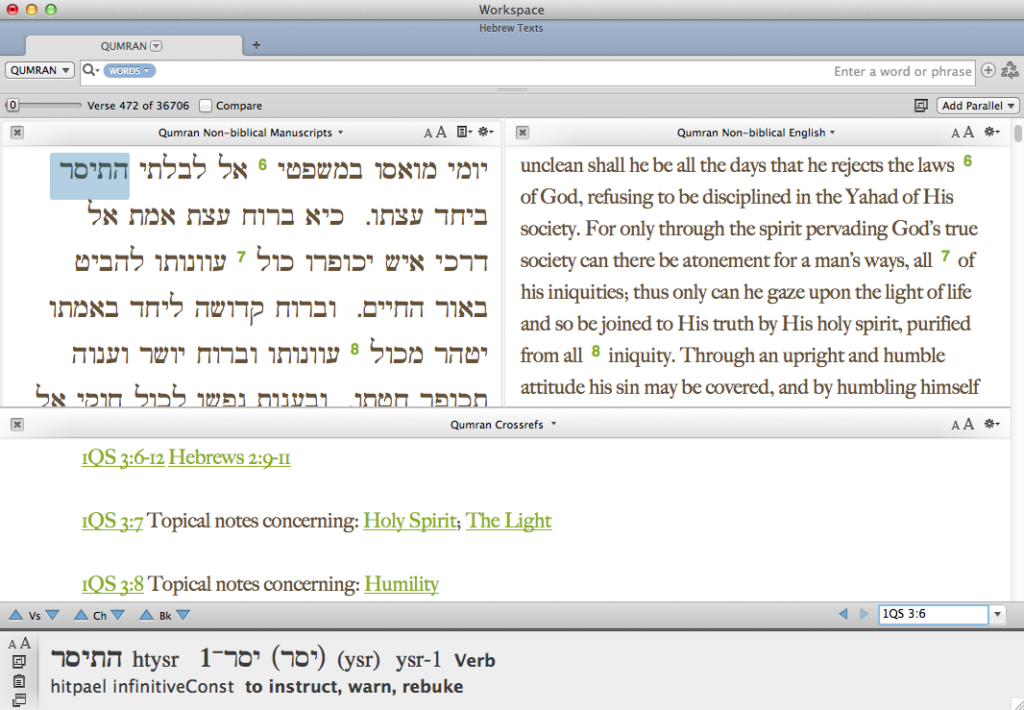What is QUMRAN?
The term Qumran was in the first instance the name of a wadi that has its source in the Judaean Hills near Jerusalem and empties into the Dead Sea just south of Jericho. This name has also been lent to the ruins of an ancient community on the marl terrace just to the north of the wadi and near the northwest bank of the Dead Sea. Further, the name has been used in the last 50 years to describe a group of manuscripts found in eleven cave surrounding the ruins of the community. These manuscripts are often referred to as the Dead Sea Scrolls.
The Nature of the Scrolls
As scroll scholars are quick to explain, the term Dead Sea Scrolls when used in the technical sense, refers to various finds ranging from north of Jericho to south at Masada, as well as several points in between. This unrelated series of finds spans a time line from as early as the fourth century BCE to as late as the second century CE. The texts originate with groups as disparate as Samaritan nobles of the north to the Jewish zealots of Masada. In the heart of this find are the 900 mostly fragmentary manuscripts found in eleven caves in the area north of Wadi Qumran on the northwest shore of the Dead Sea. The scrolls found in these caves evidence a common theological perspective that sets them apart from other Jewish groups known from antiquity. At once more strict and more apocalyptic than their fellow Jews, the members of this community—perhaps part of a larger group described as Essenes by the historian Josephus—had separated themselves from the cities and towns in the more temperate hill country. When the Romans attacked in about 70 CE the inhabitants abandoned the scrolls which they had placed in various caves. There they remained untouched until found by local Bedouin shepherds and western archaeologists between 1947 and 1956.
The Nature of the Qumran Module
Eventually all of the Dead Sea Scrolls will be available as Accordance modules. Presently in preparation is a module of more than 200 biblical texts discovered in the various sites around the Judaean Desert. These are the oldest Bible manuscripts known, the most ancient being more than 1300 older than the manuscript that is translated in nearly all modern Bibles (see BHS-W4). Another module that is currently being produced will contain all the non-biblical texts from the Judean Desert sites apart from Qumran. This group of documents is especially important for the student of the second Jewish revolt (second century CE). This present module–QUMRAN–contains all of the non-biblical texts from the eleven caves of Qumran. These scrolls–many scholars refer to them as the sectarian because they frequently exhibit the characteristic theology of the Qumran sect–number more than 600. The text of the module–80% Hebrew and 20% Aramaic–is in the main that of the official publication (Discoveries in the Judaean Desert, Oxford University Press) at times modified and corrected by both Martin Abegg and other students of the scrolls.
The QUMRAN module is not a replacement for the Discoveries series, since it does not include that series’ extensive notes and commentary. Rather, the QUMRAN module functions effectively as an index for the serious researcher. As a short description cannot be given in this context for 600 titles, the interested reader is encouraged to study the Read Me file that accompanies the module.

The data represented in the module has been in preparation from 1993 and was the first major text project supported directly by OakTree. The module has been the source of two major projects which provided complete proofing runs of the data. The first was The Dead Sea Scrolls Concordance, vol. 1 (Brill, 2002) and the second–forthcoming (Brill, 2005)– is a major revision of the Dead Sea Scrolls Electronic Library, vol. 2. Thus the text and morphological analysis of the module has become a recognized standard and is used by professional scroll scholars around the world.
Explanation
- The arrangement of the texts is according to cave and document number (4Q252= Cave 4, Qumran, document number 252). An index of the corpus is also available from Oak Tree and is an invaluable tool for additional bibliographic and descriptive information (Qumran Index).
- The texts are extant in columns for the larger scrolls (1QS 1:10, column 1, line 10), fragments (4Q209 f18:1, fragment 18, line 1), or a combination of fragments and columns (4Q266 f9ii:14, fragment 9, column 2, line 14).
- The text of QUMRAN can also be viewed in parallel with QUMENG an English translation from The Dead Sea Scrolls: A New Translation (HarperSanFranscisco, 1996). As this is a one volume work (a full translation would require 4 book sized volumes), there are many fragmentary text that will have no translation. It is the hope of the translators to fill in these lacking translations in the next couple of years. Already there are numerous fragments translated in QUMENG which are not in the print edition.
Check all the Dead Sea Scrolls Resources here.
Article Author: Martin Abegg, Ph.D.

